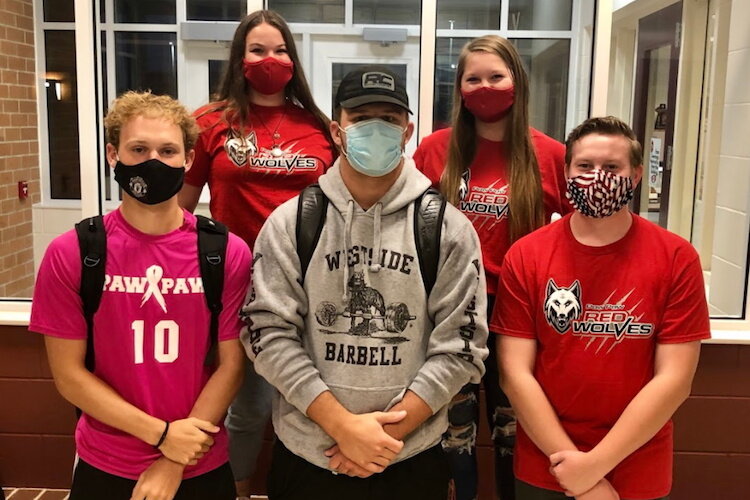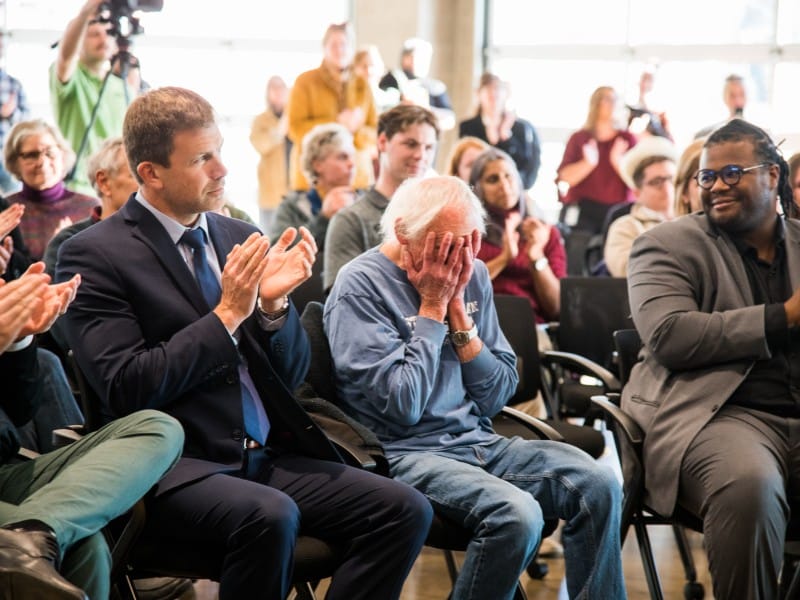Four-year-old Heritage Fund fosters an accurate appreciation for Native Americans and their history
The Native American Heritage Fund is becoming a model that the Nottawaseppi Huron Band of the Potawatomi would like to see being used to promote positive relationships for more Native American Tribes.

Before Black Lives Matter spawned a movement to take down statues and rename places that were offensive to African Americans, an organization based in Athens Township was already going about the business of redressing wrongs done to Native Americans and tribal communities throughout Michigan.
Since 2016, the Native American Heritage Fund, headquartered at the government offices of the Nottawaseppi Huron Band of the Potawatomi in Athens Township, has been providing information and funding to promote positive relationships between public and private K-12 schools, colleges, universities, local units of government and Michigan’s federally recognized Native American Tribes.
The NAHF’s work has included coming alongside the efforts made to retire school mascots at the Belding, Clinton, Godfrey-Lee, and Paw Paw school districts, in addition to the removal of the “Fountain of the Pioneers” installation at Kalamazoo’s Bronson Park, says Jamie Stuck, Native American Heritage Fund chairperson and Tribal Chairperson for the NHBP.
Now the leadership is taking on national efforts, looking for ways to have an even greater impact for Native Americans across the country and be a model for similar funds nationwide so more people can gain an understanding and appreciation for Native Americans and their history.
Their initial work primarily has been in Michigan’s schools.
“When it comes to students, it’s really about providing a safe and comfortable learning environment,” Stuck says. “People that are non-Native Americans that are uninformed as far as our history, culture, values, and traditions think these mascots are honoring us and that’s not up to them to determine.
“There’s a bad meaning behind many of these mascots that are associated with bounties on our heads during the removal of Native Americans from their land.”
For example, the original birth certificate for Stuck’s grandfather lists “Red” as his race. He was born in 1902 and is among those whose ancestors were driven from their land. For Stuck and all Native Americans, the choice of mascot nicknames like “Redskins”, which had previously been used by the Belding and Paw Paw school districts, is culturally insensitive to them and demeaning to their history and heritage.
The word “Redskin” is a racial slur as defined by Webster’s dictionary, and the term is not permitted or socially accepted when used and does not belong in an educational setting, says Melissa Kiesewetter, Tribal Liaison for the Michigan Department of Civil Rights and Treasurer of the NAHF Board of Directors.
“All 12 federally recognized tribes in Michigan unanimously approved a resolution calling for the elimination of the R** word in Michigan schools and there are a significant number of resolutions from throughout the country at all levels and from all types of organizations and institutions that support such removal,” Kiesewetter says.
“It is the position of this department, supported by national NA (Native American) organizations and supported by psychological studies, that such mascots and imagery do harm. Native Americans are not mascots and their cultural/spiritual items should not be appropriated for other’s use.”
From the point in time that they came into use these mascot nicknames have been a source of deep concern for Native Americans and tribal communities. They have been calling for change and removal of mascots ever since, Kiesewetter says. She cites the many initiatives and movements locally, regionally, and nationally.
In 2016, at the request of students and community members who said the mascot was racist, Belding school board members voted to change their nickname to the Black Knights. The Paw Paw schools followed suit in June of 2020 when they adopted the Red Wolves as their new nickname.
Stuck says he was not contacted by the Belding schools during their debate over removing their mascot. Leadership with the Pokagon Band of Potawatomi Indians and the NAHF were asked to provide information and assistance to the Paw Paw schools where a contentious debate had been going on for several years, according to Corey Harbaugh, Paw Paw’s Director of Curriculum.
The superintendent who had been there for much of this debate and had advocated for the mascot name change was replaced by current Superintendent Rick Reo. Harbaugh says, “She had tried to change the mascot and there was so much division that it marked the end of her tenure here.”
In 2019, Reo asked his administrative team to look at the current mission statement and that resulted in a new mission statement, which reignited the mascot debate.
“Superintendent Reo looked at it and realized that in order to be true to that mission we had to take on the nickname issue again,” Harbaugh says.
The mission statement reads: “We develop, support, challenge, and inspire and every child for life-long success.”
Harbaugh says it was the focus on the new mission statement that really changed the dialog in the community.
“We started to have conversations as a leadership team about what it means to represent every child,” he says. “To stay true to that mission you can’t have division or community division if you’re going to represent all students in our schools. We started having community conversations about how best we could serve our students and live up to the ethics and higher calling in that mission statement.
“We realized we could not have kids walking our halls who could not be true to the nickname.”
Out of the 2,300 students who attend Paw Paw schools, about 650 at the high school, less than 10 percent are Black, Brown or Indigenous, Harbaugh says.
“One of the most important things that happens in ages 6 to 18 is that they have those formative experiences tied to identity and we have so many students who said, ‘I can’t identify with a name that’s so hurtful for me personally,’” Harbaugh says. “We want all of our students to feel a pride and connection to the school they identify with.
“We wanted a nickname that brought all students together and didn’t divide them.” Harbaugh says he uses the term “nickname” instead of mascot because a nickname becomes the brand that dictates the design and language used for the mascot.
The Michigan Department of Civil Rights’ Tribal Liaison Kiesewetter and Sam Morseau, former Education Director for the Pokagon Band, lent their expertise to the renaming effort. Students had been taking field trips where they learned more about the Pokagon Band, something that was not being supported by their curriculum.
Harbaugh says the school system also has had access to multiple tribes and discussions about acknowledging that the land occupied by the Paw Paw schools was once owned by the Pokagon Band. He says an acknowledgment ceremony is a respectful way to honor the Native Americans.
Providing support to do what’s right
Kiesewetter says the Michigan Department of Civil Rights responds to requests for information, resources, and guidance and provides training when requested.
As it seeks changes in the use of mascots, the MDCR does not work from the context of a mascot or image being offensive but from the context of its harm it does to Native American students, students of color, and white students, she says.
“We provide the supporting evidence developed by Dr. Stephanie Fryberg at U of M regarding the harm that is done by mascots/imagery to Native AND non-Native students. We also identify how a mascot/image might be in opposition or contradiction to the institution’s mission statement, strategic plan, or other guiding documents. We also take the approach that such mascots/images create a hostile learning environment. We also will enhance these conversations by providing more authentic and accurate information, history, and context about NA population, tribal government, and tribal communities.”
Harbaugh says, “Moving from the old nickname to the new one provides us with an opportunity to increase our education on Native Americans and do it in a way so it becomes an authentic part of our curriculum,” Harbaugh says. “We’re talking about how we think through issues of representation. Now that we’re the Red Wolves, we want to make sure every decision we’re making is a real clear step away from the old nickname and that’s where the NAHF (Native American Heritage Fund) has been particularly helpful as we’re thinking through that.”
As part of the move to change the mascot, a 27-student task force was assembled and it listened to presentations from members of the Pokagon Band and the MDCR about Native American history and the current state of tribes and indigenous people. One of the students said the new nickname had to be inclusive, create a sense of pride, and be something unique to Paw Paw.
“We used those criteria and got hundreds of suggestions and the task force applied the criteria. Right away we eliminated anything that didn’t fit,” Harbaugh says. “No other school in Michigan had the nickname Red Wolves. It sends a message of inclusivity because wolves are in packs, unique and special, but we really wanted it to stress connectivity.”
While the Native American Heritage Fund’s work focuses for now on Michigan, the NHBP has gotten involved in the mascot debate at the national level. Stuck says NHBP tribal members took buses to Washington, D.C., to protest and picket against that city’s professional football team – the Washington Redskins. In addition, he says every time the Detroit Lions played the Redskins in Detroit, a suite at Ford Field owned by FireKeeeprs Casino Hotel was empty and blacked out in protest.
In July of this year, the team changed its nickname to the Washington Football Team. Stuck says Washington retired its mascot because of pressure from sponsors like Nike, FedEx, and Pepsi.
“Towards the end, if it wasn’t for Nike or FedEx putting pressure on the owner of the team the name change wouldn’t have happened,” he says. “More and more people are contemplating the change.”
Closer to home it’s the advocacy of members of the NAHF and Michigan’s 12 tribes that are changing the narrative and providing the funding to make that happen.
A conversation changes the conversation
Stuck says the Native American Heritage Fund was formed after conversations took place with then-Governor Rick Snyder.
In 2016, an amendment was made to the Tribal-State Gaming Compact between NHBP and the state of Michigan that allowed for the creation of the Native American Heritage Fund. The amendment allows for a portion of each year’s state revenue sharing payment to be deposited into the NAHF. Beginning with the 2016 fiscal period, $500,000 was deposited into the heritage fund. For each fiscal period moving forward, funds will be deposited into the NAHF to replace the amount used during the previous fiscal period and thus maintain the balance of $500,000.
Each year the NAHF puts out a call for applications for disbursements from the available pool of funds. Kelli Scott, Calhoun County Administrator, and administrator for the NAHF, said this year marks the third year for the fund disbursements. She says the issues the NAHF board was most aware of during the first funding year were changes that colleges wanted to make to include curriculum about Native Americans and schools looking to change their current mascots.
“We chose to focus on education that first year and most of the applications we get are from colleges,” Scott says. “More than 60 percent of the funds. $334,690.60 that first year, went to the Belding schools which needed funding to support the change in their signage. That was a really big impact project.”
Those funds were to support the replacement of equipment, apparel, and signage following the revision of the school’s mascot from Redskins to Black Knights. The second-largest disbursement in 2018, $76,765, was given to the City of Kalamazoo to assist with the removal of the Fountain of Pioneers and site improvements at Bronson Park.
“Most of the other disbursements were given to help support initiatives for curriculum development or community events to get those communities better connected with their tribes,” Scott says.
Recipients included Bay de Noc Community College, Lake Superior State University, Michigan Technological University and Suttons Bay Public Schools, according to the NAHF website.
In 2019, Monroe County Community College received $199,234 to create a curriculum and a set of immersion experiences for K-12 students, focused on how to research stories from the Native perspective and Northern Michigan University received $134,613 to expand Anishinabék language course offerings at undergraduate and graduate levels.
During that same funding cycle, Godfrey Lee Schools received $98,000 to rebrand the current mascot from “Rebels” to a new mascot and nickname that is culturally responsive, Stuck says.
“We do have a lot of different mixtures of ethnicities in our tribes, including African American and Hispanic,” Stuck says. “While the mascot name ‘rebel’ doesn’t have a direct impact on Native American imagery, it does have an impact on all minorities.
“Prior to the development of the fund, the costs associated with making those changes was one of the obstacles for a lot of schools to make those changes. If you have a school district that knows it’s (their mascot is) not right and wants to make the change we want to do what we can to support that effort. If it wasn’t for us, Belding may have taken decades to make the change. Schools just don’t have the money for this.”
Harbaugh says his school district will be submitting a grant application to help cover costs related to things like the rebranding of materials and changing floorboards to reflect their new mascot.
Scott says the Native American Heritage Fund receives about one dozen grant applications each year.
“The intent is to make as big an impact as we can,” she says. “One of the things that the board chose to prioritize from applicants is for them to demonstrate that they have partnered with a tribe. We want to know to what extent they collaborated and if they have support from one of 12 Native American tribes in Michigan.”
Stuck says the NAHF has become a model that he would like to see used on a national scale. He says he has been contacted by organizations in other states, including Texas and Ohio, who want to know how they can secure NAHF funding. Currently, that pool of funds is only available to entities in Michigan. He says he would like to take the model national and secure more funding to help others to gain an understanding and appreciation for Native Americans and their history.
“We are lucky enough to have an agreement with the State of Michigan that enables us to change our structure to make the NAHF a reality,” Stuck says. “We are grateful to have the opportunity to partner with these schools and organizations to correct historical inaccuracies and cultural insensitivities that have been disruptive and destructive to the lives of so many Native Americans. The NAHF represents a positive path forward to create mutual respect for all people.”














